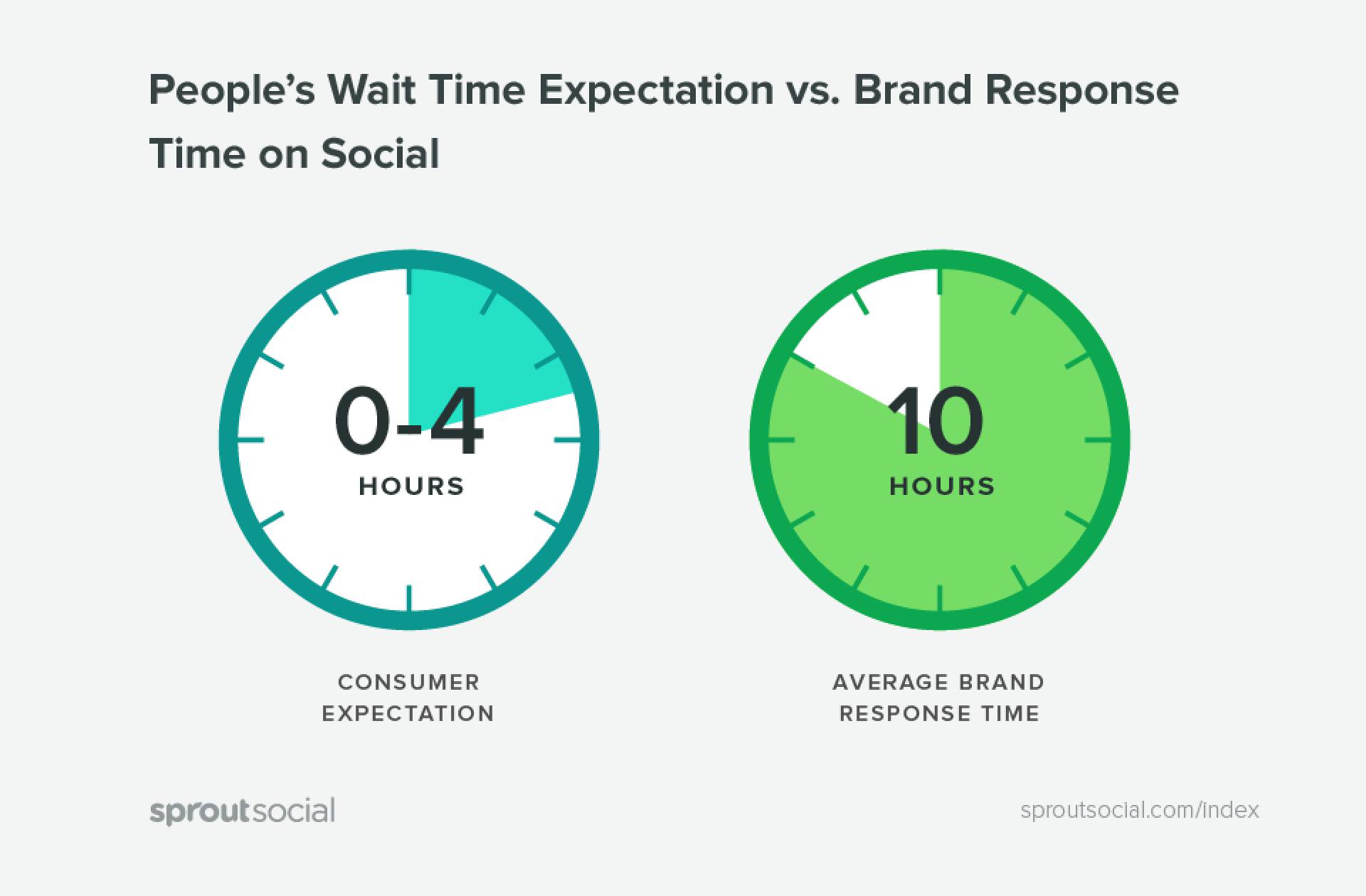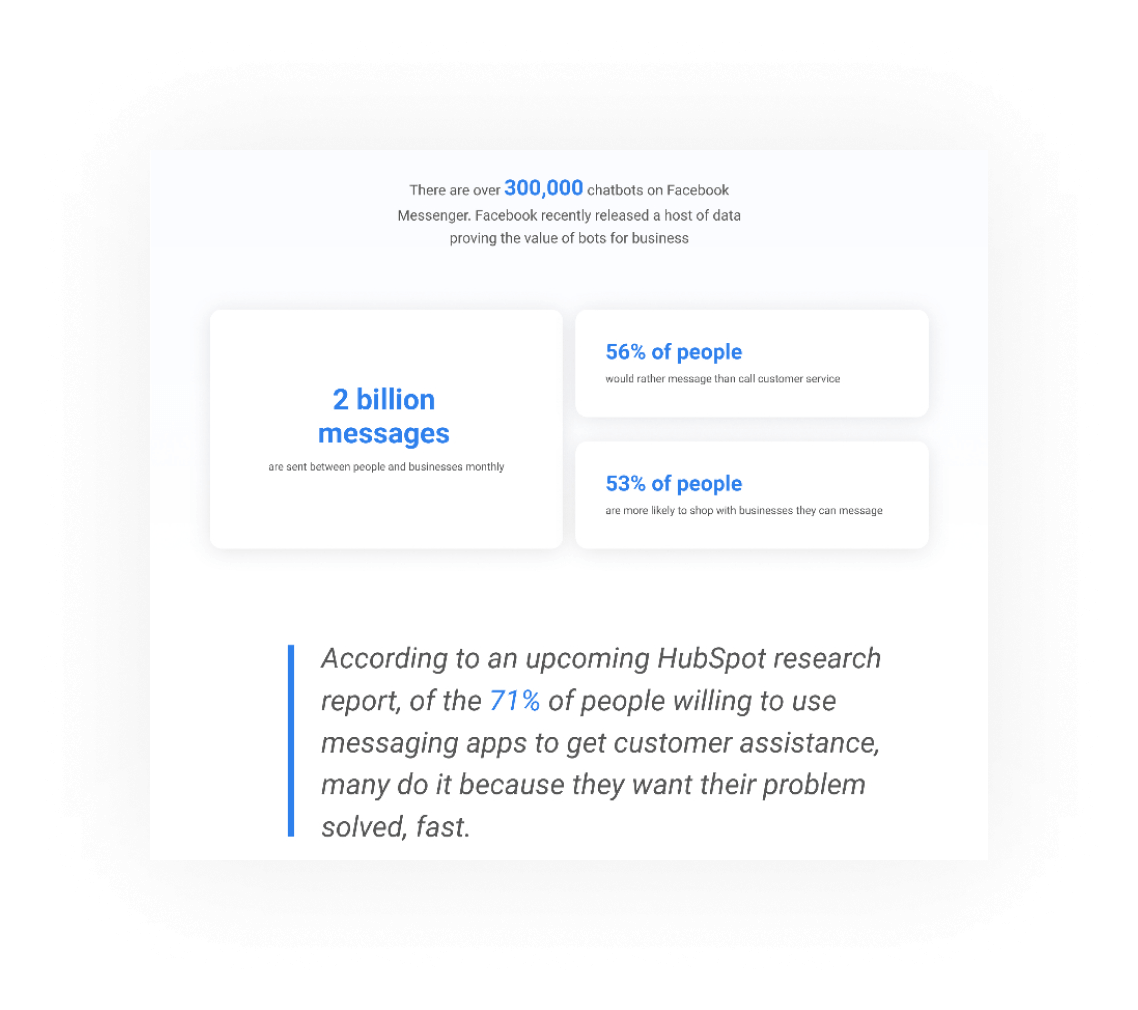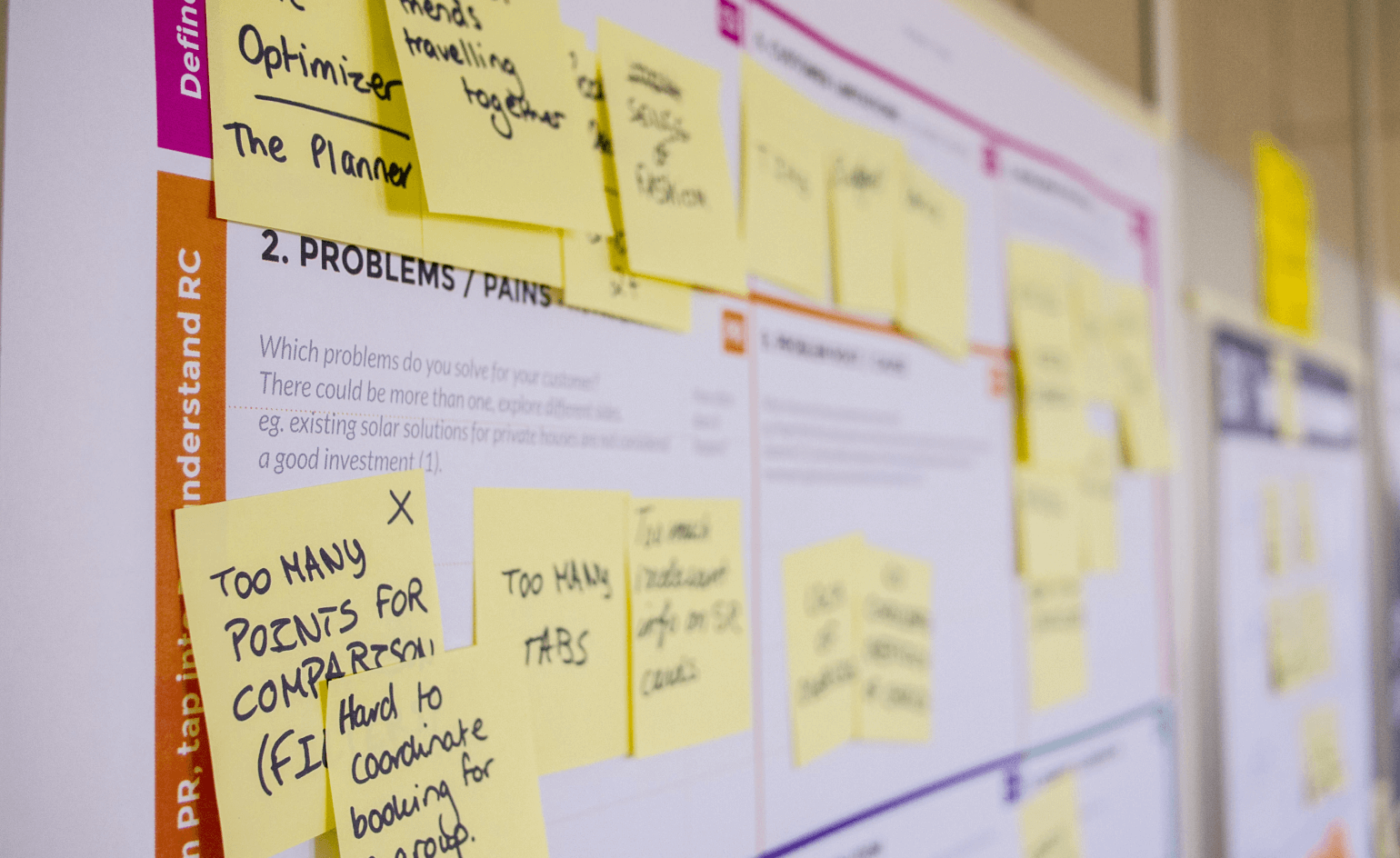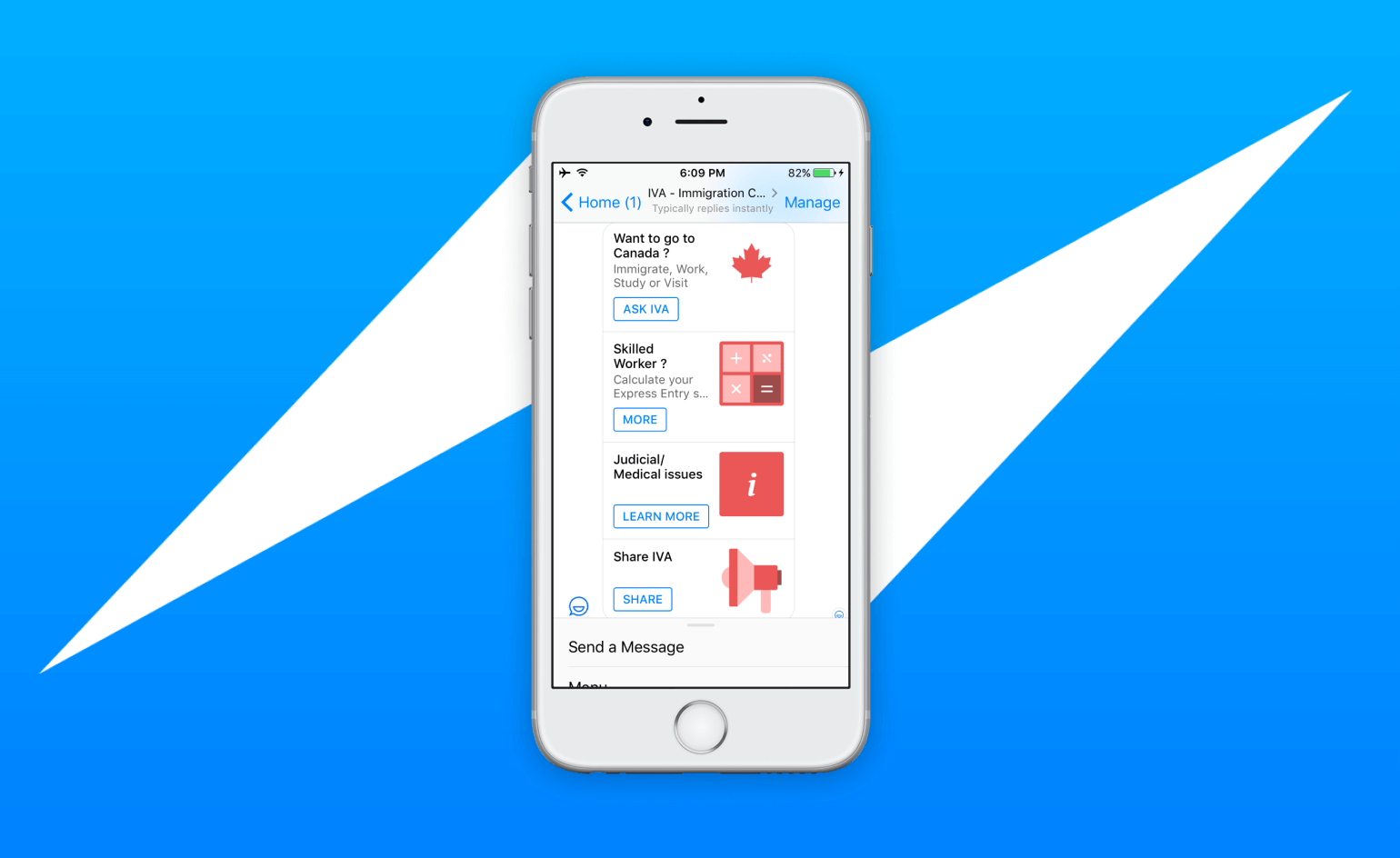


The only WhatsApp guide you won't find anywhere else.



Every business owner knows that every day it is getting harder to reach to both old and new customers.
According to the DMA’s Email benchmarking report 2018, email open rates across industries are 18.1% on average, and Click-through rates are 1.9%.
This means that more than 80% of clients don’t open your emails not even talking about reading it.
With the rise of social media and messaging apps, email has given up its position as the main communication channel between a business and a client. According to the research conducted by HubSpot, “55% of consumers want to communicate with a business using messaging apps.”
Today, people use messenger to chat with their friends, relatives, to connect with different brands, search for products and look for some content.
So, the question is how to reach out to old customers and engage new ones efficiently?
One of the most innovative solutions is chatbots.
There are over 300,000 chatbots on Facebook Messenger. Facebook recently released a host of data proving the value of bots for business:
- 2 billion messages are sent between people and businesses monthly
- 56% of people would rather message than call customer service
- 53% of people are more likely to shop with businesses they can message
This gives brands the ultimate possibility to interact with customers on a platform that they already use on a daily basis. Social media enable business owners to reach out an audience of a billion to offer their services and products. Additionally, most of the users is a younger age group which is a highly important demographic for advertisers, publishers, and brands.
A chatbot is a service powered by rules and sometimes artificial intelligence. Users communicate with a chatbot via the chat interface, similar to how they would talk to a real person.
It’s a computer program that simulates a natural human conversation. You can communicate with chatbots using voice command or text messaging.
Chatbots interpret and process user’s words or phrases and give an instant pre-set answer.
There are three main types of chatbots:
This is the simplest type of chatbot today. Usually, a user would interact with them using buttons and predefined options. This type of chatbot requires the user to make a few selections so the bot could give a better and more relevant answer. Due to that, this type of bots have longer user journey, and they are the slowest to guide the customer to the desired goal.
These bots are great when it comes to answering basic customer support issues your customer address the most. The chatbot - asks questions, and the user answers them with buttons. Based on that, the chatbot sums up collected info and provides a reply. But, when it comes to more advanced scenarios with many conditions or factors, these chatbots aren’t always the best solution.
These bots are based on Machine Learning which helps the system, in our case a chatbot, learn from user’s inputs and requests. Here’s a great article from Cassie Kozyrkov where you can learn more about machine learning: The simplest explanation of machine learning you’ll ever read )
Long story short, these chatbots are trained to understand certain keywords and phrases that trigger bot’s reply. These trigger phrases can also be combined with buttons and menus that make it even easier for a user to interact with a bot.
For example, you write to a chatbot: “I have a problem with logging into my account”. The bot would understand the words “problem” “logging” “account” and would provide a predefined answer based on these phrases.
These type of chatbot is the most advanced. It uses machine learning and AI (Artificial Intelligence) to remember the context of the conversation and user preferences. These bots can jump from one point of predefined conversation scenario to another when needed and address random user request at any moment of interaction.
Let’s imagine you are talking to Ailira, an AI-powered chatbot-lawyer, to create a Will. Ailira would ask you a set of questions to collect information needed to create a document. At some point, you can stumble upon an unknown legal term for example “beneficiary”. You can ask Ailira “What is a beneficiary?” and it would give you an instant reply and then get back to filling out your Will from the point where you stopped. After collecting the necessary data, the chatbot would process the information, create a document and store it in the conversation, where a user can download it.
Chatbots can be used for a variety of purposes: from everyday tasks to business affairs. Their main goal is to make people’s lives much easier. They can take upon simple actions like ordering a taxi and more complex like generating legal documents. Here are few of the most common chatbot use cases:
Chatbots can be created to sell any kinds of goods your company is producing. For example, a popular Skyscanner flight search engine has a chatbot in the Facebook Messenger.
On the one hand, the chatbot helps Skyscanner to sell their flights and engage with their customers. On the other hand, the chatbot greatly simplifies the travel experience for a user by providing the most inexpensive destinations based on a small amount of information that is provided by the person. A user needs to enter the travel dates, and the city of departure and the chatbot will instantly find you a travel destination. This eliminates manual research that wastes travelers time and nerves.
Chatbots are often used by online shops and private individuals offering their services. Bots help customers in the process of buying, they provide the best matching solution based on users preferences, so a person wouldn’t make many efforts to find the right product.

The most common practice for using chatbots is for customer service. Chatbots automate the communication with customers and help businesses save on customer service costs by speeding up response times, freeing up agents for more challenging work, and answering up to 80% of routine questions.
The benefit of using customer support chatbot for users is that they get an immediate reply. There is no need to wait, you can write directly to business and get a real-time answer. Chatbots reply instantly making sure you won’t lose prospect again.
For example, the German company Tec InStore has always had a lot of requests from their customers. Clients were describing problems they were having with their phones, asking customer support many typical questions. It took a lot of money and efforts to satisfy every customer and answer on questions. By using chatbot to provide users with information to the most popular questions, Tec InStore was able to cut down a number of request to a customer support center by 50%.
Chatbots for delivery are extremely popular. The most common usage of this kind of chatbots is food delivery service. You don’t have to call and wait, you can write to a chatbot, see pictures of food and take your time to decide what you want.
For example, Domino’s chatbot. A user can place an order for a pizza in Facebook Messenger and even check the status of the order and track a delivery.

Chatbots can be great helpers in everyday life. They can remind you of important meetings, plans and other things that you have planned. For example, Hello Jarvis - a FB Messenger chatbot that can create shopping lists or create and plan your tasks for a day in the form of to-do lists with reminders. Moreover, chatbots can be added and used in group chats to create and assign tasks for group members while continuing chatting.
Chatbots are used by many newspapers, magazines and TV channels. For example, the bot from CNN shows articles on the topic chosen by the user and provides a subscriber with the news and the freshest publications.
Chatbots are a great solution if you want to distribute your content efficiently. If you have a blog or you create any material (videos, podcasts, etc.), you can advertise it with chatbot in messengers, – it’s a very convenient way to keep track of new releases, besides, users will have access to all recent publications and company's news so they would hardly miss something.

Some bots play the role of a friend or a psychologist – they can always lend an ear and give actual life advice.
For example, Woebot is a chatbot that helps users monitor their mood and asks about their feelings and wellness in the form of friendly daily conversations. Chatbot provides users with helpful content like videos depending on a person's mood. Woebot works using Cognitive Behavioral Therapy and applies its techniques to help users feel better.
Chatbots are also created for learning – they provide educational material on the discipline they teach (small volume texts), “communicate” with students and evaluate their knowledge through testing. The creators of such bots are trying to make the “teacher” sound like a human as much as possible.
For example telegram bot Words helps you to learn new words via tests, games, etc.
Healthcare chatbots can advise treatment based on the symptoms of a user or find the nearest hospital. These chatbots take their knowledge from medical directories to provide the most relevant and trustworthy information to users. In such bots, you have to input your inquiry and bot will try to answer it. Or the bot can check in with your health state. Then, of course, you should schedule an appointment with a doctor.
For example - Dr. Dean chatbot. A chatbot and a custom voice-assistant device which provides information about symptoms, remedies, and supplements. Dr. Dean chatbot gives users information concerning their health conditions and ways for treatment. Also, she checks on the patient within a couple of days and provides additional remedies if needed.

Chatbots are being actively implemented in the legal industry as well. They save lawyers` time as well as their money. Chatbot-lawyers can assist users with consultations regarding legal questions, provide information over topics and even generate legal documents.
For example, legal chatbot Ailira for Messenger and a chatbot for a website (website widget). This chatbot, generates documents, provides helpful legal information and can even schedule users an additional consultation with a human-lawyer. Ailira frees up lawyers time and users money, as the chatbot generates documents cheaper and faster than a lawyer could. One of Ailira’s key advantages is that she answers legal questions with helpful and valuable information to users in a comprehensive way.
We live in an era of technological progress where you can find apps basically for your every need. But everything in our world is changing so fast that we have to ask ourselves if apps are that convenient as we used to think?
Today people’s mobiles are already overcrowded with various apps. To use chatbot, You don’t need to download a special app. They use your existing messengers such as Facebook, Telegram, Slack, Kik, WhatsApp.
“20 years ago was a website. 10 years ago was social media. 5 years ago was an app. Today, it’s messaging. And it is the largest platform shift we’ve ever seen.” Shane Mac, CEO @Assist. Curious.
You don’t need to store a massive variety of apps on your phone using chatbots. When a bot becomes irrelevant it just simply stays in your messages, and you don’t have to uninstall it. If you don’t want to store conversation with a chatbot in your inbox, you can delete the whole chat history in a few seconds.
Another great benefit of chatbots is that they are much easier, faster and cheaper to develop.
Launching a chatbot comparing to apps is faster because the messaging app, where your chatbot is going to be is already built. All you need is to develop a chatbot which is much less complex than developing an app.
Over the past few years, a lot of different chatbot building platforms were created. These platforms are easy to use for people without coding knowledge and are relatively cheap. Using these platforms, you can create simple chatbots that can perform and answer basic user requests. If you want a more complex functionality, Natural Language Processing( NLP) or don’t have time to develop a chatbot yourself, you can contact chatbot development company that will develop the bot instead of you. And usually, it still would be much cheaper than app development

“99.99% of apps are sitting on the sideline, and their tech goes unused. Through Simplicity, chatbots can Solve this Problem.” Stefan Kojouharov, Founder at Chatbots Life and Chatbot Consultant
Recent studies show that there are currently 2 million mobile apps available for iOS devices and 2 million available for Android devices as well.
This shows that it is tough for an app to get noticed. The other problem with an app is that they must constantly be updated. Every year, new OS versions are released, and if you don’t update your app, it will become unsupported on the latest devices.
Therefore, you also have to upgrade the design of your app not to fall behind and be in trend. Failing to update an app’s design can sometimes be enough to lose users over time.
Nowadays many companies use chatbots to give customers some info, to notify about updates, to promote the product or to accept payment and for many other purposes. Here are the top business chatbot advantages:
There is no denying the faster you can respond to a potential client the more likely the odds will be for closing a deal.
A study conducted by SproutSocial indicates that most consumers expect to receive a response from a company within the first 4 hours. In reality, the average brand response time is around 10 hours.

A study conducted by Harvard Business Review indicates that many companies are too slow to follow up on their leads.
People nowadays are not willing to wait on the hours to go by to only receive a response from their email. Customers will naturally choose the vendor that requires less effort to get in touch with and which provides faster support.
“Chatbots are a huge business opportunity for anyone willing to jump headfirst and build something people want.” Matt Schlicht, CEO of Octane AI, Founder of Chatbots Magazine.
The right interface is essential for a great customer experience which will keep customers engaged with a company. Chatbots are built in chat messengers which is why a bot interface will be natural for users since they use messengers every day to communicate and connect with friends and family. This gives a business the opportunity to reach out to customers on a platform they trust and create a personalized conversation that makes users feel at ease and confident when using your services or buying your product.

Chatbots are your dependable employees. They don’t require sleep nor breaks and are always willing to consult and provide clients with instant answers 24/7. Chatbots are working all the time and they don’t go on vacations or celebrate holidays. They create an uiltimate customer experience by instantly addresing user’s requests at any time of the day or week. While your employees are resting, a chatbot is constantly working to help your customers with their issues.
Conducting client satisfaction surveys and collecting comments about your services can play a major role in the development of your company. Chatbots can gather and provide feedback collected during conversations to help understand the targeted market better. If allowed by a user, a business may even analyze conversations to better understand customer behavior and methods to provide services or products in a better or different way. Hence to this, you can make adjustments for your business improvement based on a real customers’ feedback instead of assumptions
Chatbots guide and lead users through the buying process for the right products. Moreover, Messenger supports payments what sets up a hassle-free purchasing opportunity without customers ever leaving Facebook. In the long run, this interaction between a bot and a person has a massive positive impact on sales rates.
Chatbots can engage with an extraordinary amount of potential clients and ensure that leads stay connected after initial contact. Bots can collect information such as location, price range, gender, characteristics as well as many more marketing insights.
A chatbot qualifies leads so employees will not spend time on leads that would eventually turn out to be dead ends. A bot would simply ask a person a few simple questions to gather the necessary data and details about them. Moreover, bots can be integrated into your CRM system and automatically add new leads or update information on current clients.
A great aspect about chatbots is that they keep users on the same platform. As an outcome, it reduces the bounce rate. Website visitors find it annoying and inconvenient to fill out excessively long and inefficient forms. As a result, a big portion of site users quit halfway through before completing out these forms.
Conversing with a chatbot to collect information about a user is much more convenient than redirecting a person to a different website, page or window so they could fill out a registration form on their own. Messenger enables people to ask questions and get instant answers, receive payments, generate documents, fill out forms, order products, schedule meetings and many other tasks without leaving messaging apps
Using chatbots for marketing is great. A business can reach and re-reach thousands of people with personalized messages and offers. And it is imperative that sending a customized message gives you a better chance at starting meaningful conversations that will convert in the end.
Plus, as mentioned before, average open rate in Messenger is near 80-90% compared to less than 20% for email. And average CTR (Click Through Rate) on Messenger is 30% while emails CTR is only 3.3%.
Bots can naturally reach back to leads with direct and personalized messages with discounts, special offers or notifications about updates etc. Chatbots have the opportunity to reach people where they spend most of their time and to create interesting and interactive conversations that will keep leads engaged with the brand.

Before you start building a chatbot, there are a few vital things that you have to think about. We have highlighted 4 important steps completing wich will give you a great start and would be beneficial during a whole chatbot development process.
The first thing to do before starting a chatbot development process is to highlight the reason for implementing a chatbot. This could be understood as the main goal of your chatbot, namely to understand what problem the chatbot will be tackling.
We’d recommend you to answer a few questions first:
“Why are you developing a chatbot?”
“What will exactly a chatbot be doing?”
“Which problem would it solve?”

The second step is to understand that a chatbot must directly solve the end-user problem or optimize processes inside the company.
Focus on finding a real problem that your targeted audience might have. Think about what are the most common, repeatable actions that can be automated within a specific industry. Remember, you do not have to overload the chatbot with additional and unnecessary features, especially if solving such problems already exists with more efficient solutions.
The next step will be identifying a target audience for your bot. Who will have a need for this bot? Only after that, you may proceed to establish the overall project requirements.
For any type of product, it's important to understand who its end user is. The same applies to chatbots. Take your time and think:
What is an average age of a person who will be communicating with your chatbot?
Are they 25 or maybe 50 years old?
What kind of job do they have?
Are they working in an office and use their laptop?
Or maybe they are doing their job in another way?
What are their interests?
What problems can occur in their everyday life so chatbot can become the best solution for them?
This is a highly important step because based on how you made the buying persona for your chatbot, it will be incorporated into the bot's personality.
When you complete these three important steps, you will be able to move to the fourth step - developing the minimum viable product or otherwise known as the “MVP”. This would be the most simple version of the bot that could be made with having all the functionality to carry out its objective function.
Many developers fall into the same trap by beginning to develop a chatbot without the proper knowledge of how to actually start. They do not conduct the preliminary expertise and do not follow these 4 important steps that were mentioned above. And as a result, they do end up with a low-quality working chatbot. They get a chatbot which is able to solve different kinds of tasks but all the while offer little to no value to its end user.
We would like to emphasize that the development process for chatbots works the same as for the development process of any other software product. They all require a diligent amount of time and effort to get your chatbot up and running successfully.
CUI (Conversational User Interface) is a bridge between your product and its users. It is a crucial factor in helping a business communicate with its clients.
Simply put, CUI is a communication with technology by way of text or voice conversation. CUI enables users to interact with machines in an understandable human language. This greatly simplifies the communications between a chatbot and your customer. CUI makes a chatbot more accessible and friendly for an average user.
By opting to a conversation, a business may casually offer their services and products as well as promote new products, collect feedback, and chat with users in the most natural way with the convenience to the user.
A chatbot can be a friend to clients providing them with assistance and helpful advice need. It can be as different as you wish – serious and formal, witty and adventurous or careful and professional. It’s up to you to choose your chatbot personality.

How do people interact with the outside world? Let’s say that every object has an interface. We can easily ask how to use a pen, door or book just by looking at it. We don’t have to memorize complicated usage instructions. If we had previous interactions with a similar item, we would know how to use it. But what happens when we come across an incomprehensible, complex interface? We get lost, scratch our heads and not know where to click, which buttons to press and where to search for required information. A chatbot simplifies the user’s experience by guiding users. That’s why it is incredibly important to build a naturally understandable and easy to navigate CUI for a chatbot.
An optimal CUI will guide users through the unfamiliar for them interface to help them effortlessly get to a desired outcome with the product or service. Using the right CUI, a business can lead its customers to actions they need to take to achieve their goal, provide them with assistance and maybe even keep communicating with the person for future marketing campaigns.
Here are our thoughts on that:
– The usual interface. Every day, people interact with dozens of people using different messaging platforms. Users already know this interface and they don’t need to learn everything from scratch.
– No need to download apps – users add chatbot to their messenger the same as they would add their friend. No need to go through a registration process and bog down phones with unnecessary applications.
– People tend to trust more advice from someone they know. Chatbots create simple conversations that break that distance between a business and a customer. While chatting with a bot, users feel safe and like they are talking to a reliable friend.
– With Facebook UI Elements, we can add anything to a chatbot to make it even more user-friendly.
“Brands already invest huge sums of money into building pseudo personas that define our relationship with a brand. What we’re talking about with the future of customer-facing messaging chatbots is taking that illusion one step further: personas that will feel increasingly like we’re interacting with some one, rather than some thing.” Gideon Rosenblatt, writer at The Vital Edge
There are many different ways how to market chatbot depending on the messaging platform where it is located.
For example, if a bot is launched on a website, it can bring a slight to no change to your overall marketing strategy. The goal is to acquire website visitors through inbound and outbound campaigns, while the chatbot remains your conversion force. You can make the chatbot widget proactive. This means the chatbot will pop up and write a specific message when the user is on a specific part of the website. It helps to convert site visitors into customers.

Instead of linking an ad from a newsfeed to another website, now FB Messenger is a destination point for ads. Facebook Messenger ads give users the opportunity to communicate instantly with your business by only clicking on your ad.
– No forms
Now people do not need to fill out forms; they immediately do it in chatbot in a more engaging way.
– Staying on the same platform
There is no need to redirect the user to the site what often causes the loss of a lead. All sales processes take place in Messenger and have much fewer barriers such as loading time, a new interface to learn, and an overwhelming amount of choices.
Another great way how to promote chatbots are Facebook comments.
Let’s imagine, you created a post where you offer a 30% discount for any tour.
The only thing required from the user is to start an interaction with your business by writing a code word in the comments. Let's say, this word is “SALE". When a user writes this comment, the bot will immediately be able to message that user and propose tours with a discount.
How you could understand, this is another useful option for lead generation. Even if the user doesn’t make a purchase, you are still able to keep him in your pipeline and propose new discounts later on
What is a referral link?
This is a link which will direct a user to a particular part of the conversation flow, but not at the beginning of the conversation.
Let's suppose, we need to generate new leads.
You may create an ad with text such as: “Find out which country is your ideal vacation destination". We will add a referral link to a Call-To-Action button that leads to a certain point of the conversation. When a user clicks on the button, he is redirected to a specific part of the conversational flow and the chatbot would automatically start chatting with a new user about ideal vacation place. The chatbot will ask the user some questions and then will offer them the most fitting vacation spots based on their responses.
Sequences have a great impact on “user engagement". For example, the bot may reach out to users to check in on them or to follow up and collect feedback or give a satisfaction survey. Business can use this feedback to upgrade their services or to offer users new recommendations based on their answers and preferences. It allows to keep users engaged, build relationships, and to make an upsell to your existing customers.
Now it’s time to think about what you need to do after launching your chatbot to not fall into common traps. In this final stage, you’ll learn a set of certain steps that would be beneficial to complete during the first life cycle stage of a chatbot.
The first and foremost priority is analyzing your chatbot’s interactions with users.
This means you need to find the areas your chatbot is having trouble with and fix them. Perhaps, the bot wasn’t sure how to respond to a situation, or it was simply not interesting to communicate with for users.
It is possible to keep track of how smoothly your bot is operating by connecting it with analytics. To name a few, there are dashbot.io, chatbase, and botanalytics.
A chatbot has a basic set of answers after its launch, but its “teacher", creator or developer, should always be behind the scenes improving it. If talking about a rule-based chatbot, then you would need to react to the cases where the bot did not respond to users’ messages. Such issues can be caused by the wrong flow set up. So you should go back to the development process and solve the issue.
Sometimes the user may stop interacting with a bot in the middle of the conversational flow. It means you have to make improvements on the chatbot's flow and user interface, change around the decision tree and make the UI more engaging.
However, AI-powered chatbots should be trained in another manner, since they are powered by Natural Language Processing. You should select the phrases that the bot could not understand and teach it to respond to them correctly. Keep cycling through this process until it understands how to answer to all of the questions that it should be capable of answering.
We recommend you to have a person who will monitor the work of the chatbot during the initial launch period. The main task of this person would be to take over the communication process if something were to go wrong. This will help you not to lose the lead and potential client.
Also, be sure to add a Live Chat option that way users can always have the opportunity to talk to an actual person if needed.
The General Data Protection Regulation (GDPR) is a regulation on data protection for European Union citizens. It also applies to the transfer of personal data outside of the EU area. GDPR gives users control over their personal information and whether they want to share or keep their data private.
If you are looking for a GDPR Requirements Checklist check out our guide on how to make your chatbot GDPR compliant.
There are a few options if you are looking for a bot framework to boost start your chatbot development. The most popular and common one is Microsoft Bot Framework. It enables to build, deploy and maintain chatbots on platforms like Cortana, Microsoft Teams, Skype, Slack, Facebook Messenger, website and more.
Another platform that is great for building bots in Java is BotsCrew Bot Framework - the lightweight Java framework that enables users to design their chatbot effortlessly. The framework eliminates the problems with specific messaging platforms that may occur while developing a bot. Bot Framework allows you to build well-structured conversations with users by helping to create a logical and engaging flow that is divided into relevant blocks. The framework lets you get your chatbot up and running and is simple to use even for those with no experience with chatbots.
You can find BotsCrew Bot Framework and guidelines in our article.
There are a few messaging platforms where you can launch your chatbot. When considering different platforms, the most important focus should be on your targeted audience. You have to understand in which messaging platform your targeted persona hangs out the most. Choose the platform where your users already are and be sure that it aligns with your company.

FB Messenger

Whats App

Skype

Telegram

Slack

Kik

Check out our framework and guide for building bots on Messenger. Also, we have a step-by-step guide for building bots on What’sApp.
BotsCrew Bot Framework
How to build WhatsApp chatbot
How to make your chatbot GDPR complaint
5 Genius Ways to Promote Facebook Messenger Chatbots
Why chatbot are the future of marketing
The 2018 State of Chatbots Report: How Chatbots Are Reshaping Online Experiences
The complete guide to chatbots in 2018